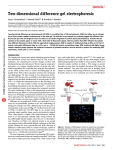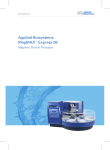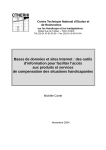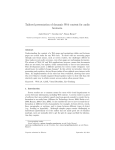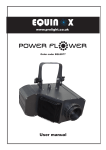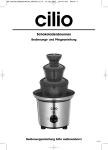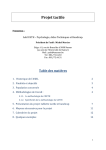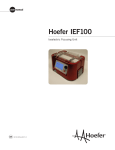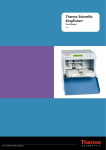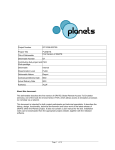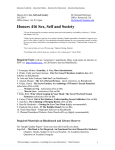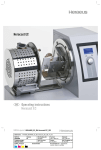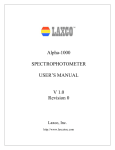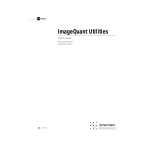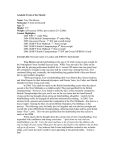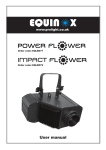Download UNCORRECTED PROOF
Transcript
Book_Wang_9781597454636_Proof1_December 31, 2007 9 01 02 05 06 07 08 Difference In-Gel Electrophoresis: A High-Resolution Protein Biomarker Research Tool RO O 04 F 03 09 10 11 David S. Gibson, David Bramwell, and Caitriona Scaife DP 12 13 14 15 Summary 16 19 20 21 22 23 TE 18 Difference in-gel electrophoresis (DIGE) is a recent adaptation of conventional twodimensional gel electrophoresis (2-DE) that incorporates novel fluorescent labels, has multiplex attributes, and boasts software-assisted image analysis. Combined, these characteristics offer significant benefits in accuracy and reproducibility to quantify differential protein expression levels between biological samples. The DIGE technique and materials required to perform it are described in detail within. The principles behind consistent gel image acquisition and reliable image analysis are also considered. Within the context of biomarker and drug target discovery, this method simplifies analysis, increases sample throughput, and represents a reliable 2-DE platform. RR EC 17 24 25 26 Key Words: Biomarker; Cy dye; DIGE; fluorescent difference in-gel electrophoresis; proteomics; two-dimensional gel electrophoresis 27 28 29 1. INTRODUCTION TO DIFFERENCE IN-GEL ELECTROPHORESIS 30 33 34 35 36 37 38 39 Two-dimensional gel electrophoresis (2-DE) is an established platform that facilitates the analysis of complex protein mixtures. O’Farrell was first to introduce high-resolution two-dimensional electrophoresis by resolving proteins to individual isoelectric point and molecular weight coordinates (1). The main asset of this method is that it provides a global view of the state of proteins within a sample. In theory, thousands of proteins can be visualized at once, giving a unique qualitative “map” or “fingerprint” of changes CO 32 UN 31 40 From: Methods in Pharmacology and Toxicology: Biomarker Methods in Drug Discovery and Development Edited by: F. Wang © Humana Press, Totowa, NJ 41 189 Book_Wang_9781597454636_Proof1_December 31, 2007 190 07 08 09 10 11 12 13 14 15 16 17 18 19 20 21 22 23 24 25 26 27 28 29 30 31 32 33 34 35 36 37 38 39 40 41 F RO O 06 DP 05 TE 04 RR EC 03 between given samples. Though many developments, such as standardized immobilized pH gradients, have led to vast improvement in inter-run consistency, deficiencies in sensitivity and spot matching have necessitated further adaptation using fluorescent stains. Comparison between large groups of conventionally (silver or Coomassie) stained gels is complicated by spot to spot warping, caused by variations in sodium dodecyl sulfate– polyacrylamide gel electrophoresis (SDS-PAGE) gel casting, electric and pH fields, and thermal fluctuations during electrophoresis. This leads to problems in spot matching and necessitates multiple gel replicates to prevent assumptions on mismatched proteins. In other words, gel to gel heterogeneity makes it difficult to distinguish with confidence between variations in the technique and those of genuine induced biological change, such as in disease states (2). Difference in-gel electrophoresis (DIGE) addresses a number of these issues in that two to three samples can be subjected to exactly the same running conditions within a single gel. Unlu et al. developed DIGE to allow a more direct and reproducible comparison between protein samples, differentiated by prelabeling with spectrally resolvable fluorescent cyanine, or Cy, dyes (3). The Cy dyes are charge matched with the residues they bind to within the proteins of a given sample and have similar molecular weights (0.5 kDa), thus result in only slight gel shifts. The Cy dyes are based on extended organic ring structures and hence are highly hydrophobic. Concerns with protein precipitation prior to electrophoresis have been surmounted by using a “minimal labeling” strategy, whereby binding is limited to only 1% to 2% of lysine residues available within a sample (4). Excitation of each fluor allows the creation of a digital image of each individually labeled sample. These dyes give additional validity to the twodimensional technique in the form of higher sensitivity, wider dynamic range, and linearity of detection. Detection limits of 0.025 ng are possible, with a dynamic range around five orders of magnitude. One of the strongest features of the technique, however, is the ability to include an internal pooled standard, which is loaded on all gels within an experiment (5). The internal standard permits the linking of all gels in an experiment, thus offering more reliable and intuitive software-assisted comparisons. The accuracy of protein quantification between samples is increased dramatically, and much smaller changes in protein expression can be studied with greater confidence. Evaluations of DIGE alongside traditional and more recent proteomic methods using isotope-coded or isobaric tags (cICAT and iTRAQ) reveal that it remains competitive in sensitivity and can be used with confidence as a platform for drug discovery and development (4,6). CO 02 UN 01 Gibson et al. Book_Wang_9781597454636_Proof1_December 31, 2007 Difference In-Gel Electrophoresis 05 06 07 08 09 10 11 12 13 14 15 16 17 F 04 Because three cyanine dyes are available, up to three separate protein samples can be labeled per gel. A pairwise analysis and organization could also be used (akin to gene chip analysis), where control versus drug-treated samples are labelled with Cy3 and Cy5 only. When normalization of expression levels is desired across a number of different experiments and within the one experiment, adequate quantities of each sample should be available to create a common pooled internal standard. The internal standard can be distinguished from experimental samples by labeling with Cy2 dye. Anomalies in spot intensity due to preferential labeling can be eliminated by randomized or reciprocal labeling, in which half of each experimental group is labeled with Cy3 and the other with Cy5 (7). In order to distinguish intrinsic, interindividual biological variation from genuine changes in protein expression, biological replicates should be included in each experimental group. A recent study focused on the DIGE technique has shown that a minimum of four replicate gels is required to maintain a 95% chance of avoiding false negatives, when a twofold change in expression is considered significant (8). RO O 03 2. DIGE EXPERIMENT CONSIDERATIONS DP 02 18 19 3. SAMPLE PREPARATION 20 24 25 26 27 28 29 30 31 32 33 34 35 36 37 38 39 40 41 RR EC 23 CO 22 Plasma and synovial fluid are used in this chapter to illustrate and describe the steps required for the purification and minimal fluorescent labeling of body fluid samples. For details of how to prepare cell lysates, with both minimal and saturation types of labeling, one can refer to the Ettan DIGE system user manual (9). The following reagents and conditions have been used in our laboratory to produce reliable data with clinical relevance to patient outcome but could also be applied to prospective drug trial to monitor therapeutic response. Sample preparation should be consistent and kept as simple as possible to reduce inter-run inconsistencies. Protein modifications during sample preparation must be prevented, particularly degradation due to endogenous proteolytic enzymes. Such changes in samples analyzed by gel-based approaches can translate into misleading artifact spots with novel molecular weights. 3.1. Sample Purification and Assay UN 21 TE 01 191 Cellular or particulate material should be removed from the body fluid by centrifugation prior to any further purification steps. This circumvents contamination by sub-proteomes other than that of the body fluid that is to be analyzed. Endogenous protease activity should be inactivated for reasons already eluded to above. A number of approaches are possible, with Book_Wang_9781597454636_Proof1_December 31, 2007 192 07 08 09 10 11 12 13 14 15 16 17 18 19 20 21 22 23 24 25 26 27 28 29 30 31 32 33 34 35 36 37 38 39 40 41 F RO O 06 AQ2 DP 05 AQ1 TE 04 RR EC 03 varying consequences to the resulting sample integrity. Protease inhibitor cocktails (such as the Complete Protease Inhibitor Cocktail Tablets; Roche) can be used to inactivate a wide variety of degradative enzyme classes including cysteine, matrix metallo and serine proteases. This remains our preferred method of body fluid stabilization, and an adaptation is now also available, in the form of a blood tube with proprietary inhibitors for immediate and convenient sample protection (BD P100). Some authors, however, caution against their use in certain applications, as artifacts can result from modified protein charge, or peptide-based inhibitors such as leupeptin may interfere with mass spectrometry analysis (10,11). Proteases may also be inactivated by high or low pH extremes with Tris buffer or trichloroacetic acid (TCA), respectively, or alternatively total protein can be precipitated by TCA/acetone. In balance though, protein yield may be diminished by incomplete precipitation or resolubilization. Once stabilized, salts can be removed from protein samples (if higher than 10 mM) by dialysis with low-molecular-weight cut-off membranes, though if analysis of small peptides is desired, precipitation could be implemented. Other macromolecules such as lipids, polysaccharides, and nucleic acids should be removed by organic solvent, unless present at low concentrations (as with plasma). The sample can be lyophilized if concentration is necessary (5 to 10 mg/mL is an ideal protein concentration, though labeling of 1 mg/mL is possible) and resuspended in a minimal quantity of DIGE-compatible lysis buffer [DLB; 30 mM Tris, 7 M urea, 2 M thiourea, 4% (w/v) CHAPS, pH 8.5]. Ampholytes and dithiothreitol (DTT) are omitted from the lysis buffer prior to the labeling reaction as both primary amines and thiol groups will compete with the proteins for the available Cy dye. The pH of the sample to be labeled is also critical to the reaction, so check that the sample pH is 8.5 by spotting on a pH indicator strip and, if necessary, make drop-wise adjustments with dilute sodium hydroxide. The concentration of protein in each sample should be assayed either by Bradford reagent or using the proprietary Ettan 2D Quant kit (GE Healthcare). CO 02 3.2. Sample Labeling Aside from the pH and protein concentration recommendations already made, the efficiency of minimal dye labeling is dependent on the ratio of dye to protein (400 pmol Cy dye to 50 μg protein is cited in the DIGE user manual; GE Healthcare). The Cy dye fluors should be reconstituted in anhydrous dimethyl formamide under the manufacturer’s guidelines to create a 1 mM stock solution. Each has a characteristic deep color as follows: Cy3, red; Cy5, blue; and Cy2, yellow (as shown in Fig. 1). The sample and dye quantities required for a six-gel, three-dye pilot experiment are shown UN 01 Gibson et al. AQ3 Book_Wang_9781597454636_Proof1_December 31, 2007 Difference In-Gel Electrophoresis 193 01 02 F 03 04 RO O 05 06 07 08 09 10 11 DP 12 13 14 15 16 TE 17 18 19 20 RR EC 21 22 23 24 25 Fig. 1. Schematic representation of the laboratory procedures involved in a typical DIGE experiment. 26 29 30 31 32 33 34 35 36 37 38 39 40 41 CO 28 in the following worked example (Table 1). Paired plasma and synovial fluid samples from six patients (A–F) are labeled with Cy3 and Cy5. An experimental design incorporating randomization of sample labeling and loading across gels is demonstrated to avoid systematic errors. An internal pooled standard is generated by combining equal amounts of all matched plasma and synovial fluid samples, followed by Cy2 dye labeling. Sufficient pooled internal standard is prepared to allow enough aliquots for each gel in the experiment. It is also prudent to create a slight excess (10% to 20%) of each dye reaction to ensure a complete aliquot is loaded on each gel. Thus for the individual plasma and samples, 60 μg is labeled with Cy3 or Cy5, but only 50 μg will be loaded of each. A single internal standard is therefore prepared, which comprises 30 μg of each of the 12 samples (6 plasma and 6 synovial fluid) and labeled with Cy2 dye. Before labeling, it is recommended that all sample concentrations are normalized to 10 μg/μL, to make subsequent pipetting easier (Table 2). UN 27 Book_Wang_9781597454636_Proof1_December 31, 2007 194 02 03 04 Table 1 The Sample and Dye Quantities Required for a Six-Gel, Three-Dye Pilot Experiment Are Shown for a Three-Dye Run Analyzing Plasma (PL) and Synovial Fluid (SF) from Six Patients (Anonymized as A, B, C, D, E, and F) F 01 Gibson et al. 08 09 Gel 1 2 10 11 3 12 13 4 14 15 5 16 17 18 6 Cy2 pooled standard 50 μg (4.17 μg of each A–F and PL A–F) 50 μg (4.17 μg of each A–F and PL A–F) 50 μg (4.17 μg of each A–F and PL A–F) 50 μg (4.17 μg of each A–F and PL A–F) 50 μg (4.17 μg of each A–F and PL A–F) 50 μg (4.17 μg of each A–F and PL A–F) Cy5 Cy3 sample SF 50 μg of PL C 50 μg of SF D sample SF 50 μg of SF A 50 μg of PL F sample SF 50 μg of PL B 50 μg of SF E sample SF sample SF sample SF 19 20 Beforehand: Label Reaction Tubes 21 23 24 25 30 31 32 33 34 35 36 37 38 39 40 41 50 μg of PL D 50 μg of SF B 50 μg of SF F 50 μg of PL E 4. Aliquot volumes of each sample equivalent to 100 μg into each of the first set of SF or PL individually labeled tubes. Adjust protein concentrations of all samples to 10 μg/μL by addition of DIGE compatible lysis buffer (DLB), as shown in Table 1. 5. Aliquot 6 μL of each normalized sample (60 μg) from the above, into each of the second fresh set of SF or PL individually labeled tubes and 3 μL (30 μg) of each sample into the one PS labeled tube. This gives a total of 36 μL (or 360 μg protein) in the pooled standard tube (PS). CO 29 Sample Preparation Sample Labeling UN 28 50 μg of PL A 1. Label 12 Microfuge tubes (0.5 mL) as Table 2 (SF A-F, PL A-F) for preparation of samples prior to labeling. 2. Label a second fresh set of 12 Microfuge tubes as above, for the labeling reaction. 3. Label one Microfuge tube as PS for the pooled standard. 26 27 50 μg of SF C RR EC 22 DP 07 TE 06 RO O 05 6. The Cy dyes are diluted from 1 mM stock concentration to a working concentration of 400 pmol/μL with DMF, and 1.2 μL of the Cy3 and Cy5 dyes is added to individual samples in a randomized fashion as described in Table 1. An aliquot of 7.2 μL of 400 pmol/μL Cy2 is added to the pooled standard tube. (Note: Only reconstitute minimal quantities of Cy dye working dilutions for AQ4 07 08 09 10 11 12 13 14 15 16 17 18 19 20 21 22 23 24 25 26 27 28 29 30 31 32 33 34 35 36 37 38 39 40 41 CO 06 UN 05 4.8 3.4 5.7 8.5 5.7 3.6 2.5 2.8 4.3 3.8 4.2 3.2 [Protein] μg/μL 21.0 29.2 17.6 11.8 17.4 27.6 39.4 35.5 23.2 26.5 23.6 31.4 Sample SFA SF B SF C SF D SF E SF F PL A PL B PL C PL D PL E PL F Volume of DLB for 10 μg/μL (μL) *Sample concentrations are normalized to 10 μg/μL. Total for pooled internal standard 36 PS RO O DP TE 6 6 6 6 6 6 6 6 6 6 6 6 04 F SF A SF B SF C SF D SF E SF F PL A PL B PL C PL D PL E PL F Labeling tube 03 3 3 3 3 3 3 3 3 3 3 3 3 Volume add to individual labeling tubes (μL) 02 5.2 6.6 3.3 1.5 4.3 6.4 7.5 7.2 5.7 6.2 5.8 6.8 Volume add to PS labeling tube (μL) 01 RR EC Volume required for 100 μg (μL) Table 2 The Volumes of Samples and Diluent Required for Individual and Pooled Dye Reactions Are Shown* Book_Wang_9781597454636_Proof1_December 31, 2007 Difference In-Gel Electrophoresis 195 Book_Wang_9781597454636_Proof1_December 31, 2007 196 03 04 05 06 07 08 09 10 11 the experiment as any remaining stock can be kept for future work at –20°C for 3 months.) 7. All labeling reaction tubes should be mixed thoroughly by pipette and vortex and pulse-centrifuged to collect the mixture at the bottom. Incubate the labeling reaction tubes on ice in the dark for 30 min. (Note: Subsequent exposure of all dye reactions to ambient light, whether in IPG strip or gel, should be minimized to prevent degradation/bleaching of the fluorophore.) 8. Add 1.2 μL of 10 mM lysine to each of the Cy3 and Cy5 dye reactions and 7.2 μL to the Cy2 dye reaction to stop the labeling. Again, mix and centrifuge briefly before incubating for a further 10 min on ice in the dark. The labeling reaction is now complete, and labeled samples can be stored for up to 3 months at –70°C in a light protected container, if not used immediately. F 02 RO O 01 Gibson et al. 15 16 17 18 19 20 21 22 23 4. FIRST-DIMENSION ISOELECTRIC FOCUSING (IEF) The ampholytes and DTT that had been omitted prior to the labeling are added at this point in the form of a 2X sample buffer. The sample is denatured with dithiothreitol (DTT) and a volume equivalent to 50 μg of each individual Cy3 and Cy5 labeled sample are then combined with 50 μg of the Cy2 pooled internal standard. The mixture is subsequently rehydrated onto 24-cm immobilized pH gradient (IPG) strips for highest resolution (sample in-gel rehydration). Samples with larger quantities of high molecular weight proteins, alkaline proteins, or hydrophobic proteins are likely to be poorly absorbed into the IPG strip gel matrix and would benefit substantially from cup loading detailed elsewhere (12). TE 14 RR EC 13 DP 12 24 27 28 29 30 31 32 33 34 35 36 37 38 39 40 41 Beforehand: Prepare Buffers 1. Prepare 2X sample buffer [8 M urea, 130 mM DTT, 4% (w/v) CHAPS, 2% (v/v) IEF ampholytes 4–7] and rehydration buffer (8 M urea, 13 mM DTT, 4% (w/v) CHAPS, 1% (v/v) IEF ampholytes 4–7]. 2. Remove pH 4–7 IPG strips from freezer to thaw on bench and ensure rehydration tray is level. Note strip numbers and label six fresh microcentrifuge tubes as Table 1 (1–6). CO 26 Pooling Samples, Strip Rehydration, and Isoelectric Focusing 1. Add equal volumes of 2X sample buffer to individual Cy3 and Cy5 labeled samples (8.4 μL each) and to the Cy2 labeled pooled standard (50.4 μL), mix and leave on ice for 10 min (each tube now has 50 μg labeled protein in 14 μL). 2. Aliquot 14 μL of each Cy3, Cy5, and Cy2 labeled samples to be focused on the same IPG strip into the tubes as indicated in Table 1. Add 408 μL of rehydration buffer to each tube, mix, and centrifuge briefly. 3. Pipette each mixture into a separate channel of the rehydration tray. Peel off the protective cover from the IPG strip and carefully lower it gel side down into the rehydration buffer-sample; remove any air bubbles with a pipette tip. UN 25 Book_Wang_9781597454636_Proof1_December 31, 2007 Difference In-Gel Electrophoresis 03 04 Table 3 Isoelectric Focusing Conditions Appropriate to Proteins Soluble Within the Acidic Range pH 4–7 for 24-cm IPG Strips Voltage mode Voltage(V) Duration (h:min) 3500 1000 8000 100 — 0:10 1:00 >24 h 05 06 07 08 09 Step Gradient Step Step and hold 10 11 16 17 18 19 20 21 22 23 24 25 26 27 28 29 30 31 32 33 34 35 36 37 38 39 40 41 DP 15 4. Overlay each strip with ∼2 mL of IPG strip cover fluid to prevent evaporation and slide on the plastic cover. Cover with aluminum foil and incubate overnight (or at least 10 h) at room temperature. Low voltage applied during rehydration can improve entry of high molecular weight protein (13). 5. After adequate rehydration, use clean forceps to remove the IPG strips from the rehydration tray. Blot off excess fluid and carefully position the IPG strips (gel side up) within the ceramic manifold of the IPGphor isoelectric focusing unit (GE Healthcare). Ensure that the positive (anodic) end of each strip is oriented toward the anode of unit. 6. Apply one filter paper electrode pad, which has been moistened with de-ionized water (remove excess fluid with blotting paper), to each end of the IPG strip in such a way as to overlap the gel by approximately 3 to 5 mm. Place the respective electrodes over the filter paper pads and clip firmly in place and overlay each strip with cover fluid to prevent dehydration (108 mL for whole manifold). 7. Close the IPGphor IEF unit safety lid and the instrument running conditions can be programmed. We suggest conditions appropriate to proteins soluble within the acidic range pH 4–7, for 24-cm IPG strips (Table 3). Current should be limited to 50 μA per IPG strip. Other run conditions for the various strip sizes and pH ranges are available [Ettan IPGphor manifold user manual (80-6499-52 edition AO); GE Healthcare]. 8. Once the strips have been focused, they can be equilibrated straight away for the second dimension or stored for several months at –80°C between plastic sheets to prevent damage to the brittle frozen strips. TE 14 75 — — — RR EC 13 Volt-hours (kVh) CO 12 5. SECOND-DIMENSION SDS-PAGE (2-DE) UN AQ5 1. 2. 3. 4. F 02 RO O 01 197 In order to improve protein migration from focused IPG strip to the second-dimension separation gel, it is important to equilibrate the strips in a buffer containing sodium dodecyl sulfate (SDS), urea, and glycerol. In the first equilibration step, DTT is added to completely reduce any remaining disulfide bonds, whereas iodoacetamide is added in the second step to Book_Wang_9781597454636_Proof1_December 31, 2007 198 07 08 09 10 11 12 13 14 15 16 17 18 19 20 21 22 23 24 25 26 27 28 29 30 31 32 33 34 35 36 37 38 39 40 41 F RO O 06 AQ6 AQ7 DP 05 Beforehand: Prepare Equilibration Buffer and Gels TE 04 1. Prepare the stock SDS Equilibration buffer [50 mM Tris pH 8.8, 6 M urea, 30% (v/v) glycerol, 2% SDS (w/v)] (10 mL per strip will be required, excess can be aliquoted and stored at –20°C for future use). 2. Prepare the working-strength Gel Running buffer [25 mM Tris base, 192 mM glycine, 0.1% SDS (w/v)] (up to 25 L is required to fill the Dodeca gel tank). 3. Prepare 600 mL of gel casting solution (sufficient for six 1.0-mm, 12% gels; 100 mL per gel) [240 mL 30% (w/v) acrylamide/methylene bisacrylamide solution (37.5:1 ratio), 156 mL 4X Laemmli Resolving Gel buffer (0.375 TrisHCl pH 8.8, 0.1% SDS final concentration, 197.4 mL de-ionized water, 240 μL TEMED, 2.4 mL of 10% (w/v) ammonium persulfate (APS)]. Pass the solution through an 0.2-μm filter and degas under vacuum, prior to the addition of APS. 4. Apply waterproof adhesive tape to the sides of assembled glass plates and spacers, place into the gel caster with plastic sheet spacers, and gradually pour in the prepared mixture. Carefully layer ∼2 mL of water-saturated butanol on top of each gel to remove bubbles and create a level surface. Flush the butanol off the gels with double de-ionized water after approximately 1 h and cover the casting unit with tin foil. Ideally, gels should be cast the day before use to ensure complete polymerization. 5. Prepare a 1.0% agarose solution in Gel Running buffer with 50 mg bromophenol blue incorporated per 100 mL. Dissolve the agarose by a short incubation in a microwave on low-medium power. RR EC 03 alkylate the resultant sulfydryl groups thereby preventing reoxidation, which may complicate downstream mass spectrometry identification. In addition, the iodoacetamide “mops up” any free DTT, which may otherwise cause point-streaking artifacts, apparent in silver-stained gels. The Protean Plus Dodeca multiple gel unit (Biorad) is used in the worked example, as it can accommodate up to 12 large-format slab gels, has an in-built buffer recirculation and cooling system and plate electrodes for consistent resolution. A recipe for a 12% homogenous polyacrylamide Tris-glycine gel is also given using stabilized, high-purity Protogel reagents (National Diagnostics), though gradient gels and other buffer systems may give better resolution for select protein molecular weight ranges (14,15). It should be noted that the nature of the Cy dyes used in the DIGE technique necessitate the use of specialized low-fluorescence glass plates. The glass plates require thorough cleaning with dilute alcohol and de-ionized water using lint-free tissues to remove any dried salts or gel fragments prior to casting. CO 02 UN 01 Gibson et al. IPG Strip Equilibration 1. Prepare Equilibration buffer A by dissolving 100 mg of DTT per 10 mL of stock SDS Equilibration buffer (5 mL needed per IPG strip). Dispense a 5-mL AQ8 Book_Wang_9781597454636_Proof1_December 31, 2007 Difference In-Gel Electrophoresis 03 04 05 06 07 08 09 aliquot of buffer A into equilibration tubes and place the IPG strips carefully into each. (Disposable plastic 10-mL pipettes with the conical tip broken off are sufficiently long; reseal with parafilm between incubations.) Incubate the strips at room temperature with gentle rocking for 15 min, then decant the buffer. 2. Prepare buffer B by dissolving 250 mg of iodoacetamide per 10 mL of stock SDS Equilibration buffer (5 mL needed per IPG strip). Dispense a 5-mL aliquot of buffer B into each equilibration tube and reseal. Equilibrate the strips for a further 15 min at room temperature with gentle rocking, decant the buffer, and proceed to electrophoresis section. F 02 RO O 01 199 10 16 17 18 19 20 21 22 23 24 25 26 27 28 29 30 31 32 33 34 35 36 37 38 39 40 41 DP 15 TE 14 1. Rinse the equilibrated IPG strips in Gel Running buffer and using forceps place each strip across the top of a gel, such that the plastic backing of the strip makes contact with the back glass plate and the anodic end of the strip is at the top left of the gel. A thin spatula can then be used to maneuver the strip down into the well, with care so no bubbles are introduced between strip and gel. A good tip is to push one end of the IPG strip down, between the glass plates, so it makes contact with the top of the gel and gradually push the opposite end down so the strip sits level on the surface. 2. Layer approximately 2 mL of premelted 1% agarose sealing solution carefully across the strip, again try to eliminate any air bubbles trapped between the strip and gel. Allow to cool and solidify for 5 min and repeat the procedure for the outstanding IPG strips. 3. Insert the prepared gel cassettes into position in the electrophoresis unit (this can be made easier by prewetting each cassette by dipping it briefly into the Gel Running buffer). Ensure the buffer chamber is filled to the manufacturer’s recommended level and place the safety lid on paying attention to the orientation of the electrodes. 4. Start the electrophoresis with 2 W per gel for 45 min followed by 17 W per gel for 4 h, both at 20°C. Alternately, for convenience, the gels can be run overnight at 0.75 W per gel. (Such an overnight run can take anything from 18 to 21 h.) The run should be terminated when the bromophenol blue dye front reaches the bottom of the gel. 5. In preparation for scanning the gels, the scanner instrument should be switched on and left to warm up for 30 min and the glass plate should be thoroughly cleaned with lint-free tissues. As DIGE gels are scanned while they are in the glass cassettes, these too should be cleaned carefully to remove any residual running buffer, gel smears, and so forth, from the surface of the plates. If not scanned immediately, gels can be individually wrapped in cling film and stored at 4°C but should be imaged as soon as possible to avoid signal loss and dissipation of focused spots. Gels stored at 4°C should also be allowed to come up to room temperature before scanning to avoid any condensation forming on the surface of the glass. RR EC 13 CO 12 SDS-PAGE UN 11 Book_Wang_9781597454636_Proof1_December 31, 2007 200 04 05 06 07 08 09 10 11 12 The capture of gel image data is a critical stage in the whole analysis workflow that can often present a source of easily prevented experimental noise. It is possible to make careless choices at this stage that can result in a 200-fold drop in sensitivity. A variety of DIGE-compatible gel scanning instruments based on charge-coupled device (CCD) or photomultiplier tube (PMT) detection technologies are available (GE Healthcare, Typhoon; Syngene, ChemiGenius; Fuji, FLA 1500; Biorad, FX Molecular Imager). Depending on the make of scanner, there are several parameters to optimize; the spatial resolution, the dynamic range, the scan content, and background offsets. These features are therefore briefly discussed and recommendations made in each case to improve the process of image acquisition. F 03 6. IMAGE ACQUISITION RO O 02 DP 01 Gibson et al. 13 14 19 20 21 22 23 24 25 26 27 28 29 30 31 32 33 34 35 36 37 38 39 40 41 Image (or spatial) resolution relates to the number of pixels (picture elements) displayed per unit length of a digital image and is often measured in dots per inch (dpi) or in micrometers (the size of the area each pixel represents). Images with a higher spatial resolution are composed of a greater number of pixels and have more image detail that those of lower spatial resolution. It is important to be aware that variations in spatial resolution will not only affect the final appearance of the image but will also impinge on the quality of spot detection and the accuracy of any subsequent quantitative measurements. At low resolutions, there are fewer pixels available to represent each spot, and as a result, spot detection and quantitative accuracy will be compromised. Image (spatial) resolution is illustrated in more detail in Fig. 2. Higher resolution means that more pixels, and hence more data, are available for the analysis: the spot highlighted in red in Fig. 3 is represented by 63 pixels at a relatively low 100 dpi resolution (Fig. 2A), compared with 485 pixels at a higher 300 dpi resolution (Fig. 2B). There is, however, a maximum resolution, which once exceeded produces minimal additional information. Once resolution is sufficient to adequately represent the smallest features, any further increases in spatial resolution simply increase the ability to represent the system “noise.” In addition, every doubling in spatial resolution quadruples the amount of data that has to be processed, which can cause problems in processing speed and file and memory management. For example, a typical 20 × 20 cm DIGE single dye image captured at 100 dpi versus 300 dpi would result in diverse file sizes of 1.2 Mb and 10.6 Mb, respectively (both at 16-bit depth). TE 18 RR EC 17 6.1. Spatial Resolution CO 16 UN 15 AQ9 Book_Wang_9781597454636_Proof1_December 31, 2007 Difference In-Gel Electrophoresis 201 01 02 F 03 04 RO O 05 06 07 08 09 10 11 DP 12 13 14 15 16 18 19 Fig. 2. Portions of two-dimensional gel image scans showing typical image quality, spot outline, and three-dimensional spot intensity (top to bottom) at 100 dpi (8-bit) and 300 dpi (16-bit) resolutions. TE 17 20 21 24 25 26 27 28 29 30 31 32 33 34 35 36 37 38 39 40 41 RR EC 23 To summarize, in most situations, 300 dpi or 100 μm will provide an image that is large enough for accurate analysis and small enough for efficient processing. However, if your gels are small (e.g., minigels), then you may need to increase the resolution to achieve this. As a rule of thumb, the active area of the gel (i.e., the area of spot material) should fall in the range 1000 to 1800 pixels in both horizontal and vertical directions. This range provides a good trade-off in information content and analysis performance. 6.2. Dynamic Range (Bit Depth) CO 22 Also referred to as color depth, bit depth or pixel depth is the number of bits used to represent the color (grayscale, intensity levels) of each pixel in an image. Greater bit depth allows a greater range of colors or shades of gray to be represented by a pixel. If possible, scan at 16-bit rather than 8-bit. The bit depth of a 16-bit image (65,536 levels of grayscale) compared with an 8-bit image (256 levels of grayscale) results in enhanced sensitivity and accuracy of quantification for less-abundant proteins. The possible grayscale levels available along with the resultant dynamic range (orders of magnitude) for the types of images commonly used in two-dimensional gel image analysis are indicated in Table 4. In reality, the images displayed on the computer UN AQ10 Book_Wang_9781597454636_Proof1_December 31, 2007 202 Gibson et al. 01 02 F 03 04 RO O 05 06 07 08 09 10 11 DP 12 13 14 15 16 TE 17 18 19 20 RR EC 21 22 23 24 25 26 27 Fig. 3. Schematic representation of the processes involved in DIGE image analysis. (see Color Plate 4, following p. x) 28 29 32 33 34 35 36 37 38 39 40 41 screen will only be represented in 256 shades of gray, and so an 8-bit image will look identical to a 16-bit image by eye. However, image analysis software can distinguish between the different levels of gray. As a rule, the more levels of gray represented in an image, the better the ability to differentiate low-abundance spots from background, and the greater the quantitative accuracy. This is further illustrated in Fig. 2, comparing spot detection in an identical area on the same two-dimensional gel, captured at 8-bit and 16-bit, respectively. The dynamic range can be adjusted in CCD camera systems by altering the exposure time and in laser-based systems by fine tuning the voltage of the PMT detector. The dynamic range should be optimized to maximize the use of available grayscale values. Aim for the maximum gray levels CO 31 UN 30 Book_Wang_9781597454636_Proof1_December 31, 2007 Difference In-Gel Electrophoresis 03 04 Table 4 The Resultant Grayscale Levels and Dynamic Range (Orders of Magnitude) Are Shown for a Range of Image Bit Depths Commonly Used to Analyze Two-dimensional Gels 05 06 Bit depth Intensity (grayscale) levels Orders of magnitude Percent of 16-bit scan 256 (28 ) 1024 (210 ) 4096 (212 ) 65,536 (216 ) 2.4 3.01 3.6 4.8 0.39 1.56 6.25 100 07 08 09 10 8 10 12 16 11 DP 12 13 18 19 20 21 22 23 24 25 26 27 28 29 30 31 32 33 34 35 36 37 38 39 40 41 TE 17 6.3. Scan Content RR EC 16 Wherever possible, it is best to try to keep the area scanned as valid gel area. It is common to see scans where there are lots of scanner bed, labels, and so forth, in the captured image. Some scanners automatically adjust the scan settings based on what they “see” so a significant proportion of the dynamic range is lost by representing scanner bed or labels. It may be best to switch off auto gain control features or, at least, outline the areas you are interested in so the scanner optimizes only the region of interest. Extra “non gel” areas provide no useful information and should be cropped prior to image analysis. These scanning artifacts can skew the image statistics, “steal” dynamic range, increase storage requirements, and cause extra work in manual stages of analysis. Another good tip for consistency (and to save time later) is to always scan gel images using the same orientation and with the same settings. Postscan processing of two-dimensional gel images using Adobe Photoshop or other general image processing software should be avoided, as CO 15 in the image to be 5% to 10% less than those available. Scanner response curves can be nonlinear, and inconsistent settings can cause issues. For DIGE experiments without a Cy2 internal standard, chose settings that optimize the dynamic range for each stain and keep these consistent. When optimizing the dynamic range, it is important to avoid saturation effects. Saturation occurs when gray levels exceed the maximum available. When a spot becomes saturated, any differences in high pixel intensities cannot be resolved, and the spot appears truncated when viewed in three dimensions. No reliable quantitative data can be generated from a saturated spot, and saturated spots may also have an overall effect on normalization if included in later analysis. UN 14 F 02 RO O 01 203 Book_Wang_9781597454636_Proof1_December 31, 2007 204 04 05 06 07 08 09 10 11 12 13 14 15 F 03 these do not maintain the integrity of your original data, and any calibration information contained in the image file will be lost. The manipulations may make the images “look better” to the human eye but are simply transforming the original data. If the images look bad in the first place, then you should try to optimize the scanning not manipulate the images digitally. If possible, use GEL or IMG/INF files formats rather than generating TIFF files. The former often contain additional grayscale calibration information, which will not be included in the TIFF version. In any case, do not use JPEG file storage format as it is a standard for “lossy” image compression, which is optimized to allow the loss of information that is least noticeable to the human eye. This does not mean it does not affect measures made by computers. Lossy compression throws information away and manipulates the image data. Converting a JPEG image back to a TIFF is not a solution; once the image has been compressed in this way, the data has been lost and cannot be retrieved. RO O 02 DP 01 Gibson et al. 16 21 22 23 24 25 26 27 28 29 30 31 32 33 34 35 36 37 38 39 40 41 TE 20 Image analysis of conventional silver or Coomassie stained twodimensional gels of individual samples can be highly subjective and very time consuming, due to inherent unpredictable distortions between gels. These inconsistencies prevent the perfect alignment and matching of spots between gels. On the other hand, DIGE-derived images from the same gel are precisely superimposable, and gel to gel spot matching is uniquely assisted by the internal standard (Cy2 labeled). So by virtue of the prelabeling and comigration of differentially labeled samples, variation in spot “coordinates” and intensity are accounted for, and gel images analysis is much more efficient (16). It is important to understand the principles that traditional software applications apply, highlight their limitations, and provide a recommended analysis workflow (depicted in Fig. 3 and see Color Plate 4, following p. x). RR EC 19 7. IMAGE ANALYSIS: SOFTWARE PRINCIPLES AND WORKFLOWS CO 18 7.1. Image Warping and Spot Matching The biggest problem in the image analysis of a gel-based experiment is data alignment. This is easy to see by comparing the state of the art statistical analysis for array-based experiments and the sorts of analysis performed on gel-based systems. The key difference between the two workflows is that the exact locations of data points are known in the array scenario. In traditional two-dimensional gel analysis, the alignment issue is tackled by a between gel spot matching stage. Most traditional analysis strategies follow UN 17 Book_Wang_9781597454636_Proof1_December 31, 2007 Difference In-Gel Electrophoresis 07 08 09 10 11 12 13 14 15 16 17 18 19 20 21 22 23 24 25 26 27 28 29 30 31 32 33 34 35 36 37 38 39 40 41 F RO O 06 DP 05 TE 04 RR EC 03 these key steps; detect spots on each gel individually, attempt to match the spots across the experiment (possibly with the assistance of whole image gel warping), measure spots, apply some form of normalization, apply statistical analysis (17). The recommended workflow (Fig. 3) is distinguished by initially warping gels, then matching and delineating spots, and imposing the same spot outlines across all gels prior to quantification. The main problem with the traditional workflow is that it is not able to provide data of sufficient quality required to perform advanced statistical analysis. The core issue is focused on missing values; that is, a data point (usually a spot) that is not available across all samples. A recent study measured 42% missing values (i.e., not experimentally induced data omission) for a 16-gel experiment (18). It has also been shown that the number of missing values increases with the number of replicates (19). This produces the predicament of reducing the extent and quality of data, as the investigator endeavors to improve statistical power by increasing the number of replicates. In the traditional analysis workflow, missing values arise from two main sources: (1) the same measurements not being taken from each gel (usually due to spot detection) and (2) the measurements not being correctly matched between gels. The same measurement not being taken from each gel has two main effects. The first is down to the fact that in traditional analysis scenarios, each gel has spots detected in isolation. This can lead to inconsistent results because essentially the pattern is determined from a single instance and as such is more prone to technical variance. The second issue is usually attributed to experimental conditions where a spot has zero expression in one or more of the groups. In this case, a spot will not be detected on an individual gel basis, and we are left with a hole in the data. Strangely, the proteomics community tends to differ with standard scientific practice with zero expression spots preferring to have no measurement or “unmatched” rather than measuring the value “zero.” This is analogous to measuring air temperature and saying “there was no temperature” when it hits zero instead of measuring and recording zero. This particular stance also forces a multiple instead of a unified statistical framework approach to analysis, which is laborious, prone to bias, and still may be suboptimal. CO 02 UN 01 205 7.2. Spot Delineation/Outline Geometric correction alone does not solve all of the issues as we would still be prone to threshold of detection issues on a per gel basis and also not matching spots that were not expressed in certain groups. The obvious next step is to stabilize and standardize the spot detection across all of the Book_Wang_9781597454636_Proof1_December 31, 2007 206 07 08 09 10 11 12 13 14 15 16 17 18 19 20 21 22 23 24 25 26 27 28 29 30 31 32 33 34 35 36 37 38 39 40 41 F RO O 06 DP 05 TE 04 RR EC 03 images within an experiment. The geometric correction combined with an “ensemble,” experiment-wide, spot pattern would go a large way to not only removing the bulk of missing values but also removing a large amount of manual intervention. We would also gain most in the low-expression spots that are harder to detect consistently on a per gel basis. If we apply geometric correction and derive a suitable outline for spots that are not undergoing experimentally induced variation, then the software can handle more than half (usually more) of the spots in an experiment fully automatically. This is essentially reverse logic where it is more efficient to bias the analysis to discount what is not changing rather than to optimize for what may be. This also removes the situation where you have to spend a lot of time editing a series of spots to find “they don’t change.” Considering the efficiency of overall analysis, applying the same spot outlines across geometrically corrected images is advantageous, and the benefits increase as the number of spots subject to experimentally induced expression changes decreases. A restriction imposed by the same spot outlines is that the area considered to contain a spot is consistent across images. This means that there are only going to be issues if the expression change is so large that it cannot be represented by the same area across the gels. For spots in isolation, this is not an issue as a larger area can be used (any extra pixels included in the larger boundary will be zero in the smaller spots). Tight clusters of spots that vary slightly in location and potentially patterns of spots that overlap when considered across all groupings may however prove problematic and require additional editing. Interestingly, posttranslational modification shifts of proteins are better handled by the same outlines workflow than the traditional approach, as one can apply a robust statistical framework to discovering them. Therefore, contrary to current practice and “gut feel,” it appears to be more favorable to apply the same spot outline pattern to geometrically corrected gels and robustly analyze the bulk of the spots within the experiment in a “first pass” with minimal manual intervention and hence bias. Once the same outlines analysis has been completed, one will have a list of “interesting” areas. These will either be completely satisfactory with the automatic outlines or it may be deemed that editing should be considered. It is advisable that the initial analysis be completed fully without intervention and this analysis saved. From this, a list of areas for further examination should be made and these explored in a mode that adds to the information and not replaces it. At this point, we may consider editing outlines. The editing process is less biased when one uses the same outline across all gels within the experiment. This is because the volume of a spot is affected by the number of pixels chosen to include in its boundary; if imposed CO 02 UN 01 Gibson et al. Book_Wang_9781597454636_Proof1_December 31, 2007 Difference In-Gel Electrophoresis 04 05 06 07 08 09 10 11 12 13 14 15 16 F 03 inconsistently between groups, it is easy to introduce unintentional bias. Because there is a much reduced requirement on manual intervention, one can spend a lot more time on the areas that matter. Feedback from multiple labs has shown that differential editing is rarely necessary at all and, if it is, tends not to be a major factor in the results of the experiment. Areas where this is deemed necessary should always be treated with caution and may be a target area for future experiments where the zoom gels are used or alterations to the sample preparation improve the data quality in these areas. In summary, the suggested workflow is 1. 2. 3. 4. 5. Geometrically correct your gels. Create a spot pattern representative of all of the spots within your experiment. Analyze the spots completely. Complete statistical analysis. Create a copy of the experiment and edit/apply differential outlines on areas where it is deemed strictly necessary. 6. Complete statistical analysis. 22 23 24 25 26 27 28 29 30 31 32 33 34 35 36 37 38 39 40 41 RR EC 21 Because DIGE offers superlative sensitivity to quantify minute differences in protein expression levels, relative to conventional staining techniques, sample load is reduced accordingly (from as low as 75 μg to 200 μg per gel). Once spots of interest have been identified, it is then necessary to run a “preparative” gel with a higher sample loading (0.5 mg to 2.0 mg) ensuring sufficient protein in these spots to obtain reliable identifications by mass spectrometry (20). A spot “pick list” can be generated, such that isoelectric point and molecular weight coordinate data derived from the DIGE “analytical” gels can be transposed onto a Coomassie or silver stained gel. 9. CONCLUSION CO 20 8. PREPARATIVE GELS FOR SPOT PICKING Whereas the concept of DIGE is relatively novel, it has unique attributes that make it particularly suitable in the drug and biomarker discovery process. Because the technique is not dependent on antibody-protein or oligonucleotide-RNA/DNA affinity, it does not preclude the target identity, therefore represents changes in the sample without preemptive bias. Although extended multiplex capability and an increased dynamic range are desirable, it remains the most sensitive validated gel-based proteomic tool with direct relevance to innovation in clinical and pharmaceutical research. Improvements in dedicated analytical software have greatly increased the throughput and confidence in data derived from DIGE images. DIGE holds UN 19 TE 17 18 RO O 02 DP 01 207 Book_Wang_9781597454636_Proof1_December 31, 2007 208 02 03 much promise in the challenge to uncover new molecular targets, screen putative drug efficacy, and monitor therapeutic response for a wide range of debilitating diseases. F 01 Gibson et al. 04 11 12 13 14 15 16 17 18 19 20 21 22 23 24 25 26 27 28 29 30 31 32 33 34 35 36 37 38 39 40 41 RO O 10 DP 09 TE 08 1. O’Farrell PH. High resolution two-dimensional electrophoresis of proteins. J Biol Chem 1975;250(10):4007–4021. 2. Marouga R, David S, Hawkins E. The development of the DIGE system: 2D fluorescence difference gel analysis technology. Anal Bioanal Chem 2005;382(3):669–678. 3. Unlu M, Morgan ME, Minden JS. Difference gel electrophoresis: a single gel method for detecting changes in protein extracts. Electrophoresis 1997;18(11):2071–2077. 4. Tonge R, Shaw J, Middleton B, et al. Validation and development of fluorescence two-dimensional differential gel electrophoresis proteomics technology. Proteomics 2001;1(3):377–396. 5. Alban A, David SO, Bjorkesten L, et al. A novel experimental design for comparative two-dimensional gel analysis: two-dimensional difference gel electrophoresis incorporating a pooled internal standard. Proteomics 2003;3(1):36–44. 6. Wu WW, Wang G, Baek SJ, Shen RF. Comparative study of three proteomic quantitative methods, DIGE, cICAT, and iTRAQ, using 2D gel- or LC-MALDI TOF/TOF. J Proteome Res 2006;5(3):651–658. 7. Lilley KS, Friedman DB. All about DIGE: quantification technology for differential-display 2D-gel proteomics. Expert Rev Proteomics 2004;1(4): 401–409. 8. Karp NA, Lilley KS. Maximising sensitivity for detecting changes in protein expression: experimental design using minimal CyDyes. Proteomics 2005;5(12):3105–3115. 9. GE Healthcare. Ettan DIGE System User Manual. AB(18–1173–17). GE Healthcare, 2006:1–112. 10. Gorg A, Drewes O, Weiss W. Separation of proteins using two-dimensional gel electrophoresis. In: Simpson RJ, ed. Purifying Proteins for Proteomics—A Laboratory Manual. New York: CSHL Press, 2003:391–430. 11. Gibson DS, Blelock S, Brockbank S, et al. Proteomic analysis of recurrent joint inflammation in juvenile idiopathic arthritis. J Proteome Res 2006;5(8): 1988–1995. 12. Gorg A, Obermaier C, Boguth G, et al. The current state of twodimensional electrophoresis with immobilized pH gradients. Electrophoresis 2000;21(6):1037–1053. 13. Gorg A, Obermaier C, Boguth G, Weiss W. Recent developments in twodimensional gel electrophoresis with immobilized pH gradients: wide pH gradients up to pH 12, longer separation distances and simplified procedures. Electrophoresis 1999;20(4–5):712–717. RR EC 07 CO 06 REFERENCES UN 05 AQ11 Book_Wang_9781597454636_Proof1_December 31, 2007 Difference In-Gel Electrophoresis 05 06 07 08 09 10 11 12 13 14 15 16 17 18 F 04 RO O 03 14. Laemmli UK. Cleavage of structural proteins during the assembly of the head of bacteriophage T4. Nature 1970;227(5259):680–685. 15. Anderson NL, Anderson NG. Analytical techniques for cell fractions. XXII. Two-dimensional analysis of serum and tissue proteins: multiple gradient-slab gel electrophoresis. Anal Biochem 1978;85(2):341–354. 16. Corzett TH, Fodor IK, Choi MW, et al. Statistical analysis of the experimental variation in the proteomic characterization of human plasma by two-dimensional difference gel electrophoresis. J Proteome Res 2006;5(10):2611–2619. 17. Fodor IK, Nelson DO, Alegria-Hartman M, et al. Statistical challenges in the analysis of two-dimensional difference gel electrophoresis experiments using DeCyder. Bioinformatics 2005;21(19):3733–3740. 18. Grove H, Hollung K, Uhlen AK, Martens H, Faergestad EM. Challenges related to analysis of protein spot volumes from two-dimensional gel electrophoresis as revealed by replicate gels. J Proteome Res 2006;5(12):3399–3410. 19. Houtman R, Krijgsveld J, Kool M, et al. Lung proteome alterations in a mouse model for nonallergic asthma. Proteomics 2003;3(10):2008–2018. 20. Mahnke RC, Corzett TH, McCutchen-Maloney SL, Chromy BA. An integrated proteomic workflow for two-dimensional differential gel electrophoresis and robotic spot picking. J Proteome Res 2006;5(9):2093–2097. DP 02 TE 01 19 20 RR EC 21 22 23 24 25 26 27 28 29 33 34 35 36 37 38 39 40 41 UN 32 CO 30 31 209 Book_Wang_9781597454636_Proof1_December 31, 2007 01 02 F 03 04 RO O 05 06 07 08 09 10 11 DP 12 13 14 15 16 TE 17 18 19 20 RR EC 21 22 23 24 25 26 27 28 29 32 33 34 35 36 37 38 39 40 41 UN 31 CO 30 Book_Wang_9781597454636_Proof1_December 31, 2007 01 Chapter-9 03 04 Query No. Page No. Line No. Query F 02 192 02 Provide location of Roche. AQ2 192 07 Provide name and location of manufacturer. AQ3 192 31 Provide location of manufacturer. AQ4 194 31 AQ5 197 Table 3 We have italicized the underlined words throughout the text and table. Please check. In Table 2, define acronym DLB. 11 AQ6 198 05 Provide location of manufacturer. 12 AQ7 198 10 Provide location of manufacturer. 13 AQ8 198 26 Define acronym TEMED. 14 AQ9 200 08 Provide locations for Syngene and Fuji. AQ10 200 18 AQ11 208 28 Explain parts A and B in the legend add part labels to Fig. 2 legend. In Ref. 9, provide location of manufacturer as publisher. RO O AQ1 05 07 08 09 10 15 17 TE 16 18 19 20 RR EC 21 22 23 24 25 26 27 28 29 33 34 35 36 37 38 39 40 41 UN 32 CO 30 31 DP 06























